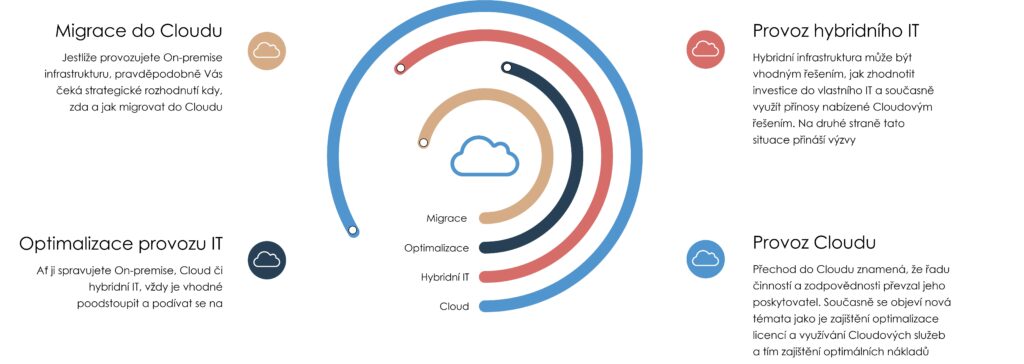So how do we approach and deal with the challenge of migrating to the cloud?
We're not there (in the Cloud) yet.
In this case, you probably run your own on-premise infrastructure and you are considering, planning or looking for a solution to adapt your current IT infrastructure, in which you have invested a lot of money, to the current needs of your company and trends in IT.
First and foremost, we need to ensure that the current systems work:
The next point is planning the next steps. It is necessary first of all:
- revise the architecture
- choose the right cloud services
- choose what to migrate to the cloud and what to keep "at home"
- to prepare management for the changes that lie ahead for the organisation, including changes in costs ranging from investments to operating costs
No matter how you feel about the cloud in your personal life, we live in a digital age, so we can't ignore the existence of the cloud. The times are such that we probably can't ignore the Cloud, no matter how we feel about it. We are doing business in the cloud age, and so it's safe to say that those who aren't in the cloud yet will soon be. For most businesses and their CIOs, this means that they are either already there or that they will soon be.
Migrating to the cloud: what's the preparation?
To migrate to cloud Approach it responsibly and with a carefully prepared strategy. Don't look at it as an impossible task, but as an opportunity to reflect on your organisation's needs, your IT architecture and your overall IT strategy. To help you do this, we've summarised a few key aspects to consider:
- Analysis and planning: The IT director should conduct a thorough analysis of the existing infrastructure and evaluate whether it is appropriate to move certain services or applications to the cloud. He should evaluate the benefits and risks associated with the migration and develop a thorough migration plan.
- Evaluation of suppliersA: It is important to evaluate different cloud service providers and select the most suitable one for your organization's needs. The CEO should evaluate parameters such as performance, availability, security and cost. He should also not underestimate the issue of IT support offered by the vendors.
- Security and data protection: The IT director must consider the security aspects of the cloud and verify that the needs of the organisation will be met. In particular, he or she should focus on implementing appropriate security measures, backing up data, and addressing privacy and compliance issues.
- Costs and financial planningA: Moving to the cloud can have significant financial implications. The IT director should perform a careful cost-benefit analysis, to include operating costs, licensing and administration. Finally, he or she should evaluate whether the organization is able to cover the costs of cloud migration and operations.
- Migration and Administration: The IT Director should develop a cloud migration plan that includes a phased migration of services and applications to the cloud with minimal impact on the organization's operations. It is also important to ensure effective management and monitoring of the cloud after migration.
- Staff training and preparationA: Migrating to the cloud usually requires that the organisation's employees are properly trained in the context of the innovations that migration will bring. The IT director should ensure that training is provided and that staff are prepared to work in the cloud and use the new tools and technologies.
- Monitoring and optimizationA: After migrating to the cloud, it is important to regularly monitor and optimize resource usage and costs. The IT director should maintain communication with the cloud provider, monitor performance and security, and conduct regular audit checks.

What reward awaits us?
What can you expect from such a change? The rewards of migrating your IT infrastructure to the cloud should be reduced costs, increased flexibility, higher availability, improved security and ease of innovation adoption for you and your organisation.
- Flexibility and scalabilityA: Cloud services make it fast and easy to adapt capacity and performance to the current needs of your organisation. The IT director can easily increase or decrease resource utilization and scale the infrastructure based on current demand.
- Cost reductionA: Cloud services can bring cost savings compared to running your own on-premise infrastructure. Organizations do not need to invest in their own hardware and data centers, minimizing the cost of maintaining and managing the infrastructure. Thus, organizations pay only for the actual resources used.
- High availability and durabilityA: Cloud providers often offer high levels of availability and resilience. How to imagine this in practice? With the cloud, an organization can access its data and services virtually around the clock without interruption, resulting in greater reliability and business continuity.
- Fast implementation and updatesA: Cloud services enable rapid implementation of new applications and updates. The IT director can use the various tools and platforms available in the cloud for efficient software deployment and management.
- Data security and backupA: Cloud providers typically invest in security measures and data backup mechanisms. This can improve data protection and reduce the risk of data loss in the event of a disaster.
- Innovative technologiesA: Cloud services often offer advanced technologies such as artificial intelligence, machine learning, big data and the Internet of Things (IoT). The CIO can leverage these innovations and integrate them into business processes and applications.
In addition to the positives, it should be mentioned that migration to the cloud brings with it a number of challenges and tasks that the IT director will have to face. These include planning and managing the migration, ensuring data security and concurrent operation with on-premise infrastructure, managing vendors and contracts, employee training, and more. Cloud migration therefore needs to be carefully prepared and supported by experts to ensure that the proposed strategy meets the needs of the organisation.
We're already there (in the Cloud) - partially or completely
The cloud is changing the way IT works. Even if you've completed your migration to the cloud, don't rest on your laurels and embrace the cloud. Above all, you need to analyze and measure the benefits your existing cloud solution brings and, if possible, optimize your operational costs.
If your organization has a hybrid infrastructure, you need to choose a strategy that effectively evaluates and ensures optimal use of the cloud while also providing tools and processes to control the combined infrastructure, this may include:
- monitoring
- a strategy for dealing with incidents and requests
When running a cloud infrastructure, you have several important tasks:
Before we close this topic, it should be said that there are many new things waiting for you in connection with the migration to the cloud. Perhaps the biggest news for CIOs and those responsible for IT in the organization is the shift in focus to two new areas, namely:
- cost monitoring and optimisation
- monitoring innovations in the field of cloud services and their adaptation, both for cost optimization reasons and for the benefits and benefits for business development.
Conclusion
Migrating to the cloud brings a number of benefits and challenges. Regardless of whether your organization is just planning a migration or is already in the cloud, you should understand that IT directors have and will play a key role in the process. Planning strategy, managing costs, training staff and monitoring performance are just some of the challenges they will face. It's important to not only monitor and optimize costs, but also stay on top of new trends and innovations in cloud services. For the success of your business in today's digital age, it's crucial to approach your cloud migration responsibly and with a thoroughly prepared strategy.


